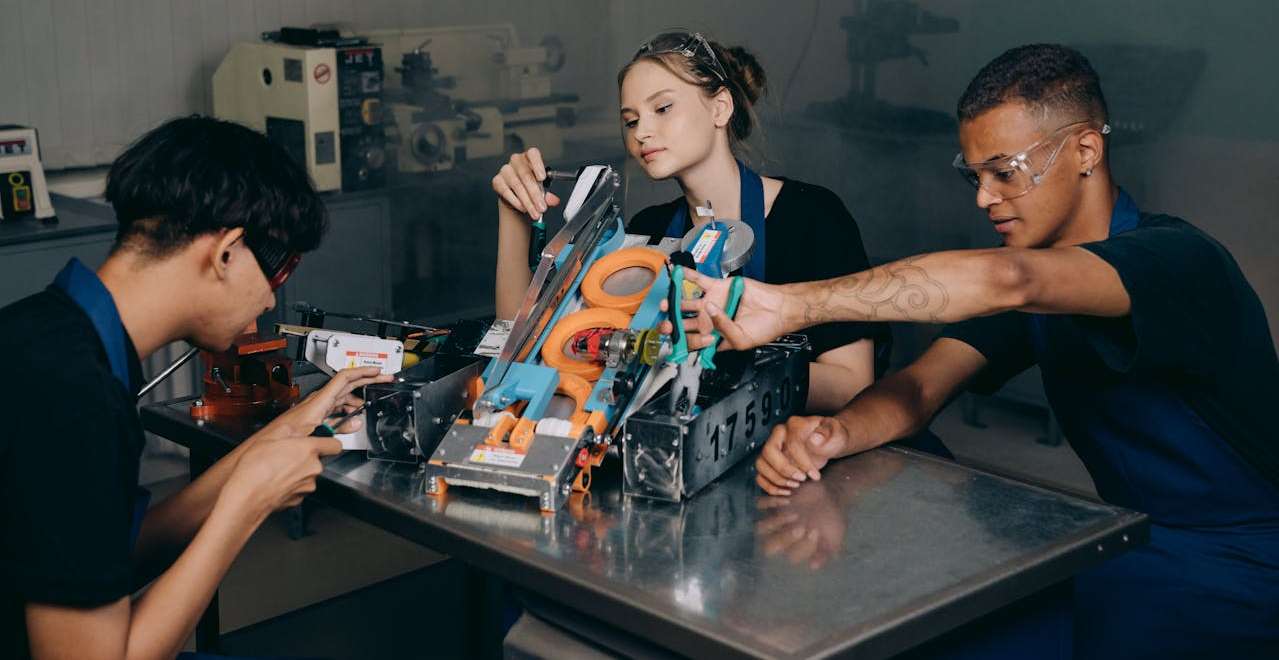Robotics is revolutionizing industries and becoming an integral part of our daily lives. From healthcare to manufacturing, robotics plays a crucial role in improving efficiency and solving complex problems. With advancements in technology, learning robotics has never been more accessible.
This blog is designed to help beginners navigate the world of robotics by exploring the best online courses available. Whether you’re looking for a robotics free online course with a certificate or want to earn a professional robotics certification online, this guide will equip you with the tools and insights needed to kickstart your journey.
Let’s explore how you can learn robotics online and make the most of the opportunities this exciting field offers.
Understanding Robotics for Beginners
What is robotics?
Robotics is a multidisciplinary field that involves the design, construction, and operation of robots. These machines are programmed to perform tasks autonomously or semi-autonomously, often mimicking human actions or exceeding human capabilities in efficiency and precision.
For example, robotic arms used in manufacturing can assemble products much faster and with greater accuracy than humans.Robotics combine elements of mechanical engineering, electrical engineering, and computer science, making it a multidisciplinary field.
Applications of robotics in daily life and industries
- Healthcare: Robots are revolutionizing healthcare with innovations like robotic assisted surgery, which enhances precision in complex procedures. For instance, the da Vinci Surgical System is widely used in minimally invasive surgeries. Robots also assist in elderly care, helping individuals with mobility and daily tasks.
- Manufacturing: In factories, robotic arms perform tasks such as assembling cars or packaging products. They ensure consistency, speed, and reduced production costs. A well known example is Tesla’s use of advanced robots in their car production lines.
- Education: Robotics kits like LEGO Mindstorms or VEX Robotics allow students to learn STEM concepts interactively by building and programming robots. This hands-on approach makes learning more engaging and effective.
- Agriculture: Robots like drones and automated tractors are transforming farming by planting seeds, monitoring crops, and harvesting efficiently. For example, the Agrobot is designed to pick fruits selectively, reducing labor dependency.
- Service industries: Robots are increasingly found in hotels and restaurants, where they can greet customers, serve food, or even clean rooms. SoftBank’s Pepper robot, for instance, is used in retail to interact with customers and provide information.

Why Learn Robotics?
- High demand and career prospects: Robotics is a rapidly growing industry with significant job opportunities. According to reports, the global robotics market is projected to reach $74 billion by 2026, making it an attractive field for future professionals.
- Fun and engaging learning: Robotics combines creativity, problem solving, and technology. Building and programming a robot to perform specific tasks is not only educational but also highly rewarding. Imagine programming a robot to follow a line or solve a maze, it’s like bringing your ideas to life!
- Transferable skills: By learning robotics, you acquire knowledge in programming languages like Python and C++, basic electronics, and mechanical design. These skills are valuable in various tech related fields, including software development and AI.
- Innovation and entrepreneurship opportunities: Robotics enables you to create unique solutions to real world problems. For instance, many startups are using robots for home automation or delivery services, which are rapidly gaining popularity.
- Accessible learning resources: Beginners can easily find robotics online courses for beginners that provide structured lessons, interactive projects, and even certifications. For example, platforms like Coursera and Udemy offer courses that require no prior experience, making it easy for anyone to start.
Key Concepts and Skills for Robotics
To excel in robotics, beginners need to grasp several foundational concepts and skills. These are the building blocks for designing, programming, and operating robots effectively.
- Basic electronics: Understanding how circuits, sensors, and actuators work is crucial for robotics. For example, knowing how to connect a motor to a power source and control it using a microcontroller is a fundamental skill.
Beginners can start by learning simple concepts like Ohm’s Law and how to use components such as resistors, LEDs, and capacitors.
- Programming languages: Learning to code is a key aspect of robotics. Languages like Python and C++ are widely used because of their flexibility and efficiency. For instance, Python is often used to program Raspberry Pi robots, while C++ is preferred for real time systems like robotic arms.
- Mechanics and design principles: Robotics involves building physical structures, so an understanding of mechanics is essential. Concepts like torque, gears, and leverage come into play when designing a robot’s movement. For example, creating a robotic arm that can lift objects requires calculating the appropriate motor strength and arm dimensions.
- Artificial Intelligence and Machine Learning basics: Many modern robots use AI to perform tasks autonomously. For example, a robot vacuum cleaner like the Roomba uses AI algorithms to map a room and avoid obstacles. Beginners should explore basic AI concepts like computer vision and path planning to understand how robots make decisions.
- Hands-on experience and practical projects: Theory alone isn’t enough in robotics. Building and programming robots through practical projects help solidify concepts. For example, assembling a line-following robot using Arduino introduces you to sensors, motors, and programming in a real world context.
Importance of practical experience in robotics online courses
Practical learning allows beginners to see how different components and concepts come together to create functional robots. Robotics kits like LEGO Mindstorms or Arduino starter kits are excellent tools for this. They provide pre-built components and guided projects, making it easier for learners to get started.
With a solid foundation in these key concepts and skills, you will be well equipped to dive deeper into robotics and take on more advanced challenges.

Features of a Good Robotics Online Course
Not all online courses are created equal, so it’s essential to choose one that meets the needs of beginners while providing a solid foundation for further learning. Here are the features to look for when selecting a robotics online course for beginners.
1. Beginner friendly curriculum
A good course should start with the basics and gradually introduce more complex concepts. For instance, it might begin with an introduction to robotics and its applications, then move on to programming, electronics, and simple projects. Look for courses labeled “robotics online courses for beginners” or those that specify no prior experience is required.
2. Interactive learning
Engagement is key to retaining knowledge. The best courses offer a mix of instructional videos, quizzes, and hands-on assignments. For example, a course might teach you how to program a robotic arm and then provide a simulation platform where you can test your code. This interactive approach keeps learners motivated and ensures practical understanding.
3. Access to mentorship or community support
Learning robotics can be challenging, and having access to mentors or a community of learners can make a big difference. Some courses provide forums, live Q&A sessions, or mentorship opportunities. For example, Coursera’s robotics certification online courses often include discussion boards where students can interact with instructors and peers.
4. Opportunities for practical projects and portfolio building
Hands-on projects are essential for developing real-world skills. A good course will include assignments like building a robot in simulation or programming a robotic arm to complete tasks. Completing these projects allows you to create a portfolio, which is invaluable when applying for internships or jobs.
5. Certifications for career growth
Many courses offer certificates upon completion, which can boost your resume and demonstrate your skills to potential employers. For instance, earning a robotics online course with a certificate from platforms like edX or Udemy adds credibility to your expertise and shows your
6. Clear and structured progression
A well-structured course should guide you step by step, starting with basic concepts and advancing toward more complex topics. For example, an ideal course would begin with understanding simple circuits and sensors, then move to coding basics, and eventually dive into advanced concepts like artificial intelligence in robotics. This structured approach ensures that learners don’t feel overwhelmed and can build their knowledge at a comfortable pace.
7. Real-world applications and case studies
A great course doesn’t just teach theory; it also provides real-world examples and case studies to show how robotics is applied in various industries. For example, the course might feature case studies of robotic arms in manufacturing or drones used in agriculture. These practical insights help you understand how what you’re learning fits into the bigger picture.

Top Robotics Online Courses for Beginners
Now that you know what to look for in a robotics course, let’s explore some of the top online courses available for beginners. These courses offer comprehensive content, hands-on projects, and certifications to help you get started in the field of robotics.
1. Coursera: Introduction to Robotics (offered by top universities)
Coursera provides a range of robotics courses in collaboration with renowned universities like the University of Pennsylvania and Stanford. These courses are beginner friendly, offering a solid introduction to robotics. They cover topics such as robot mechanics, control systems, and basic programming. Many courses also offer certificates upon completion, which can help boost your career prospects.
- Why it’s great: Coursera courses are well-structured and often include interactive assignments, video lectures, and peer reviewed projects.
- Example: The “Introduction to Robotics” course by the University of Pennsylvania covers key concepts in robotics, including sensors, actuators, and basic programming in Python.
2. edX: Robotics Foundations I (structured programs)
edX offers structured programs and professional certifications in robotics, such as the Robotics Foundations series. These courses are designed for beginners and focus on both the theory and practical aspects of robotics. They are developed by top institutions like MIT and ETH Zurich, ensuring high quality content.
- Why it’s great: edX provides an in-depth, academically rigorous approach to robotics. Courses are self-paced but come with deadlines, helping you stay on track.
- Example: The “Robotics Foundations I” course introduces fundamental concepts such as kinematics, control systems, and motion planning.
3. Udemy: Robotics for Beginners (affordable and project focused)
Udemy is known for its affordable courses, and its robotics section is no exception. The “Robotics for Beginners” course on Udemy is designed to help beginners build their first robot from scratch. The course covers everything from basic programming to designing simple robots.
- Why it’s great: Udemy courses are budget friendly and often include lifetime access, so you can revisit the material anytime. The hands-on, project focused approach makes learning practical and engaging.
- Example: The “Robotics for Beginners” course on Udemy includes a practical project where learners build a simple line following robot using Arduino.
4. FutureLearn: Basics of Robotics (short-term courses)
FutureLearn offers short term courses in robotics, perfect for those looking to get a quick overview of the field. The “Basics of Robotics” course provides a solid introduction to the key components of robotics, including sensors, actuators, and basic programming.
- Why it’s great: FutureLearn’s courses are concise, making them ideal for learners who want to dip their toes into robotics without committing to a long term course. They also include opportunities for networking with fellow students.
- Example: The “Basics of Robotics” course includes interactive modules and quizzes, allowing learners to test their understanding of the material.

5. YouTube Channels: Free resources for learning the basics
If you prefer a more flexible, self-paced approach, YouTube offers numerous free resources to learn the basics of robotics. Channels like “Jeremy Blum” and “Arduino course for everyone” provide in-depth tutorials on building robots, coding, and working with various robotics kits.
- Why it’s great: YouTube is a great resource for those who want to learn at their own pace without spending money. You can find a wide variety of tutorials for all levels, from beginner to advanced.
- Example: Jeremy Blum’s “Arduino Tutorial” series teaches how to build and program robots using Arduino, covering everything from basic circuits to more advanced robotics projects.
6. MIT OpenCourseWare: Introduction to Robotics
MIT’s OpenCourseWare (OCW) offers free access to a wealth of educational resources, including robotics courses. The “Introduction to Robotics” course is designed for beginners and covers the fundamentals of robotic systems, including robot kinematics, dynamics, and control. While it’s a bit more technical, the course provides a solid foundation for anyone interested in learning about robotics at a deeper level.
- Why it’s great: MIT OCW provides high quality academic resources for free, and the course includes lecture notes, assignments, and problem sets.
- Example: The course dives into topics like robotic motion and sensors, using practical examples to illustrate concepts.
7. LinkedIn Learning: Learning Robotics
LinkedIn Learning offers a variety of beginner-friendly robotics courses that cover the basics of building robots, programming, and applying robotics in real-world scenarios. Their “Learning Robotics” course is an excellent starting point for beginners, introducing core robotics concepts and programming using Arduino and other platforms.
- Why it’s great: LinkedIn Learning provides courses with professional development in mind. The courses are taught by industry experts, and you can showcase completed courses on your LinkedIn profile to enhance your career.
- Example: The course includes practical lessons on using Arduino to create simple robots and covers key concepts like sensors and motors.
8. Robotics Academy: Robot Programming for Beginners
The Robotics Academy offers beginner-friendly courses focused on teaching programming skills for robotics. Their “Robot Programming for Beginners” course introduces learners to basic robot programming using languages like Python and C++. It’s designed to help beginners understand the logic behind robot programming and how to control robots in various environments.
- Why it’s great: The Robotics Academy focuses on providing learners with hands-on programming experience, which is essential for building functional robots.
- Example: Learners are guided through programming robots to perform specific tasks, such as moving in a straight line or avoiding obstacles, which provides immediate, practical results.

How to Choose the Right Course
With so many options available, choosing the right robotics course can be overwhelming. Here are some tips to help you make the best decision based on your personal goals and learning style.
1. Aligning the course with your goals.
Before selecting a course, consider your long term objectives. Are you looking to learn robotics as a hobby, or are you aiming for a career in the field?
- For hobbyists: Look for courses that focus on fun, hands-on projects, such as building simple robots or using robotics kits. These courses are typically more relaxed and designed to give you an enjoyable learning experience without heavy technical demands.
- For career focused learners: Choose a more structured course with in-depth coverage of robotics concepts, programming, and real world applications. Look for certifications that are recognized by employers in the tech industry, such as those offered by edX or Coursera.
2. Checking prerequisites (e.g., basic programming knowledge)
Some robotics courses may require prior knowledge of programming or electronics. Before enrolling, review the course prerequisites to ensure you have the necessary background.
- If you have no prior experience: Look for courses specifically designed for beginners, such as “Robotics for Beginners” on Udemy or “Introduction to Robotics” on Coursera. These courses start from the basics and don’t require advanced knowledge.
- If you have some experience: If you’re already familiar with basic programming or electronics, consider courses that go deeper into topics like machine learning or advanced robot design.
3. Reading reviews and ratings from past learners
Before committing to a course, read reviews and ratings from previous students. This can provide valuable insights into the course’s quality, structure, and effectiveness.
- Where to check: Platforms like Coursera, edX, and Udemy have extensive user reviews. Look for feedback on the course content, instructor quality, and how well the course helped learners achieve their goals.
- What to look for: Pay attention to feedback on how clear the instructions are, the support available, and the relevance of the material to real world applications.
4. Balancing cost, duration, and depth of content
Robotics courses come in a wide range of price points and durations, so it’s important to choose one that fits your budget and time availability.
- Free courses: If you’re just starting and want to dip your toes into robotics, consider free options like YouTube tutorials or platforms offering robotics free online courses with certificates.
- Paid courses: If you’re looking for more structured learning and certification, consider paid courses like those on Coursera or edX. These typically provide more comprehensive material, professional mentorship, and certifications.
- Course duration: Consider how much time you can dedicate to learning. Some courses are short and can be completed in a few weeks, while others are more in-depth and may take several months.
5. Course flexibility and support
Some courses are more flexible than others in terms of pace and availability. If you have a busy schedule, choose a course that allows you to learn at your own pace.
- Self paced courses: Platforms like Udemy and Coursera offer lifetime access to course materials, so you can learn whenever it’s convenient for you.
- Structured courses: If you prefer a more structured learning environment with deadlines, consider courses that follow a set schedule, like those on edX or FutureLearn. These courses often come with more personalized support and interaction with instructors.

Tools and Platforms to Complement Learning
While taking online robotics courses is essential, having the right tools and platforms to practice and enhance your skills is equally important. Here are some resources that can complement your learning and help you build hands-on experience.
1. Robotics kits for hands-on experience
Hands-on experience is crucial in robotics, and using robotics kits can significantly enhance your understanding of how robots work. These kits often come with all the components you need to build a robot and help you practice your skills in programming, electronics, and mechanics.
- LEGO Mindstorms: This popular kit allows you to build robots with LEGO bricks and program them using a drag-and-drop interface or Python. It’s a great option for beginners and kids.
- Arduino: Arduino is a versatile platform that allows you to build robots and other electronic projects. With an Arduino kit, you can learn to wire sensors, motors, and actuators and write code to control them.
- Raspberry Pi: A Raspberry Pi is a small computer that can be used to control robots and sensors. It’s a great tool for learning programming and robotics at a deeper level.
2. Simulation platforms and coding environments
In addition to physical robotics kits, simulation software allows you to practice building and programming robots without the need for expensive hardware. These tools help you design and test robots virtually, which is particularly useful for beginners.
- Gazebo: Gazebo is a powerful robot simulation platform that provides a 3D environment for testing robotic algorithms. It’s often used in research and is great for simulating complex environments.
- VEX Robotics Design System: VEX offers a virtual robotics design system where you can simulate building and programming robots before assembling them in real life. It’s especially useful for students and educators.
- Tinkercad: Tinkercad is an easy-to-use, web-based tool for creating 3D designs and simulations. It’s ideal for beginners to learn about circuits and robot design in a visual and interactive way.
3. Online communities and forums for networking and support
Joining online communities is an excellent way to get help, share your projects, and connect with others who are learning robotics. These communities can offer advice, troubleshoot problems, and provide inspiration for your projects.
- Arduino Forum: The Arduino community is one of the largest and most active online, with a wealth of resources, tutorials, and user-created projects. You can ask questions, share your projects, and collaborate with others.
- Reddit (r/robotics): The robotics subreddit is a place where enthusiasts, students, and professionals gather to discuss the latest trends, share projects, and ask questions. It’s an excellent resource for beginners looking to connect with the community.
- RobotShop Forum: RobotShop offers a forum where users can discuss various robotics topics, from building robots to troubleshooting issues. It’s a helpful place for getting advice and feedback on your projects.
4. Cloud based robotics platforms
Cloud based platforms allow you to develop and test robotics applications remotely. These platforms often offer simulation tools, robot control, and collaboration features, making them ideal for learning and experimentation.
- VPL (Visual Programming Language): Some cloud platforms like Tinkercad and Blockly offer visual programming interfaces where beginners can easily drag and drop blocks of code to program robots. This is great for those who are just starting with programming.
- CoppeliaSim: CoppeliaSim is a versatile simulation platform that provides tools for developing robotics applications in the cloud. It’s used for academic and industrial robotics projects and supports both beginner and advanced users.
You can take your learning to the next level and gain the hands-on experience necessary to master robotics with those platforms. They provide practical ways to apply what you’ve learned in your online courses and help you build real world skills.

Tips for Beginners to Succeed in Robotics
Getting started in robotics can be challenging, but with the right approach, you can quickly gain the skills and confidence needed to succeed. Here are some essential tips to help beginners navigate the world of robotics and stay motivated along the way.
1. Dedicate time to consistent practice and project building
Robotics is a hands-on field, and the more you practice, the better you’ll get. Consistent practice is key to mastering the concepts and skills required. Set aside dedicated time each week to work on projects and apply what you’ve learned in your courses.
- Why it’s important: Robotics is all about trial and error. By working on projects, you’ll encounter challenges that help you understand the concepts more deeply and improve your problem solving skills.
- Example: Start with simple projects like building a line following a robot or creating a motion sensing system. As you progress, move on to more complex projects like autonomous drones or robotic arms.
2. Join robotics clubs or online communities
Learning is often more enjoyable and effective when you’re part of a community. Joining robotics clubs or online communities allows you to share your progress, ask for help, and get inspired by others’ projects.
- Why it’s important: Robotics can sometimes feel overwhelming, but being part of a supportive group can keep you motivated. It also gives you the opportunity to collaborate and learn from others with different skills and experiences.
- Example: Participate in online forums like the Arduino Forum or join local robotics clubs where you can collaborate on projects and participate in challenges or competitions.
3. Participate in robotics competitions and hackathons
One of the best ways to push your skills to the next level is by participating in robotics competitions and hackathons. These events provide real world challenges that will test your knowledge and push you to innovate.
- Why it’s important: Competitions help you apply your learning in a practical setting, often with time constraints and specific challenges that simulate real-world robotics applications.
- Example: Events like FIRST Robotics and RoboCup are excellent opportunities for beginners to test their skills, gain hands-on experience, and network with other enthusiasts. Many of these competitions also offer scholarships and career opportunities for participants.
4. Stay updated with the latest trends and advancements in robotics
Robotics is an ever-evolving field, and staying up to date with the latest advancements can give you a competitive edge. Follow industry news, attend webinars, and read research papers to stay informed about new technologies and trends.
- Why it’s important: Robotics is closely linked to developments in artificial intelligence, machine learning, and other cutting-edge technologies. Keeping up with these advancements will ensure that you remain at the forefront of the field.
- Example: Subscribe to robotics magazines like IEEE Robotics and Automation Magazine or follow online publications such as Robohub to stay informed about the latest breakthroughs.
5. Don’t be afraid to fail and keep experimenting
Failure is an inevitable part of the learning process, especially in a field like robotics. The key is to embrace failure as an opportunity to learn and improve. If a project doesn’t work, analyze what went wrong, adjust your approach, and try again.
- Why it’s important: Robotics often involves complex systems, and it’s natural to encounter roadblocks. The most successful learners are those who don’t give up after a failure but instead use it as a stepping stone to better solutions.
- Example: If your robot’s sensors aren’t working as expected, don’t get discouraged. Instead, debug the system, research potential solutions, and apply what you’ve learned to improve the design.
Key Takeaway on Robotics Online Courses for Beginners
Robotics is an exciting and rapidly growing field that offers endless opportunities for beginners to learn, explore, and innovate. Whether you’re interested in pursuing a career in robotics or simply looking for a fun and engaging hobby, there are plenty of resources available to help you get started.
Understanding the core concepts, selecting the right online course, and complementing your learning with hands-on experience and the right tools, you can make significant progress in your robotics journey. The key is consistency, curiosity, and a willingness to experiment and learn from both successes and failures.
Remember, robotics is a multidisciplinary field that combines electronics, programming, mechanics, and artificial intelligence. It’s a dynamic and rewarding area that is shaping the future of industries ranging from healthcare and manufacturing to education and entertainment. With the right mindset and resources, you can not only master the fundamentals but also contribute to the development of groundbreaking technologies.
So, start your learning journey today. Explore robotics online courses for beginners, join communities, and begin building your first projects. With dedication and passion, the world of robotics is yours to discover and shape.


[…] technology, and have the opportunity to work in various industries, from construction to robotics. Engineering programs typically include hands-on projects, labs, and internships to help you gain […]
[…] Read – Robotics Online Courses for Beginners […]